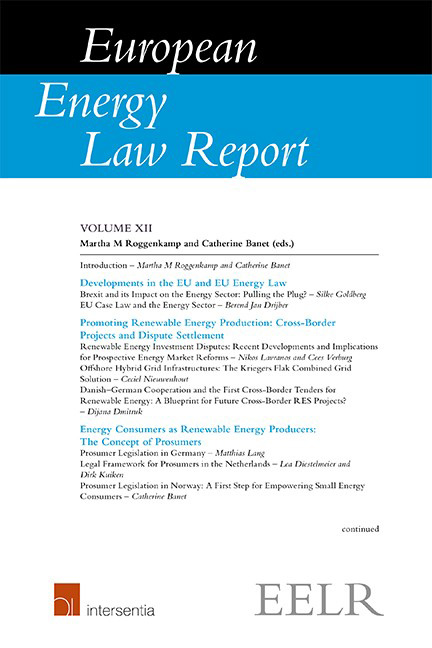Book contents
- Frontmatter
- Preface
- Contents
- List of Abbreviations
- List of Contributors
- Introduction
- PART I Developments In The EU and EU Energy Law
- PART II Promoting Renewable Energy Production: Cross-Border Projects And Dispute Settlement
- PART III Energy Consumers As Renewable Energy Producers: The Concept Of Prosumers
- PART IV Balancing Renewable Electricity Production Withsupply Security: National Experiences With Capacity Mechanisms
- PART V Promoting The Use Of Sustainable Gas And Security Of Gas Supply
- Chapter XII The Use of Power-to-Gas in Refineries: Regulatory Challenges from an EU and German Perspective
Chapter XIII - Security of Gas Supply: The New European Approach
from PART V - Promoting The Use Of Sustainable Gas And Security Of Gas Supply
Published online by Cambridge University Press: 31 January 2019
- Frontmatter
- Preface
- Contents
- List of Abbreviations
- List of Contributors
- Introduction
- PART I Developments In The EU and EU Energy Law
- PART II Promoting Renewable Energy Production: Cross-Border Projects And Dispute Settlement
- PART III Energy Consumers As Renewable Energy Producers: The Concept Of Prosumers
- PART IV Balancing Renewable Electricity Production Withsupply Security: National Experiences With Capacity Mechanisms
- PART V Promoting The Use Of Sustainable Gas And Security Of Gas Supply
- Chapter XII The Use of Power-to-Gas in Refineries: Regulatory Challenges from an EU and German Perspective
Summary
INTRODUCTION
The EU introduced a new security of gas supply regulation in November 2017, which replaces the security of gas supply regulation of 2010. It is only the second regulation on gas security of supply that the EU has ever issued. Before that, gas security of supply was mainly governed by the light-touch rules of Directive 2004/67 and was considered to be largely provided for by the principles governing the internal European energy market.
This notion changed considerably with the 2006 and 2009 Russia – Ukraine gas crises, which had a detrimental effect on the amount of gas that was received in Europe, causing, inter alia, Italian and German gas-fired power plants to shut down. 5 Subsequently, Regulation 994/2010 was put into place as an explicit response to the crises.
The new Regulation (EU) 2017/1938 is the successor to Regulation 994/2010 and is supposed to deal with the latter's perceived shortcomings. Many instruments of the predecessor Regulation (EU) 994/2010 will stay in place unchanged and those have been discussed elsewhere. This contribution will therefore focus on the innovations and changes being brought in by Regulation (EU) 2017/1938.
After providing a background on the development of Regulation (EU) 2017/1938, the chapter will make some remarks on its structure and aims. The chapter then focusses on the main innovation of Regulation (EU) 2017/1938, the imposition of obligatory solidarity between Member States in a gas crisis. This is to be achieved by two means: first, directly connected Member States are being clustered into so-called risk groups, and second, the new Article 13 of Regulation (EU) 2017/1938, which spells out concrete solidarity measures that Member States have to take in case of an emergency.
BACKGROUND
The EU deemed it necessary to introduce a new security of gas supply regulation after the Commission investigated the implementation of Regulation (EU) 994/2010 in October 2014. Although the EU insists that the old Regulation (EU) 994/2010 had a ‘significant positive impact’ on the security of gas supply in the Union, the October 2014 report identified areas in which improvements could further bolster the security of gas supplies to the Union.
- Type
- Chapter
- Information
- European Energy Law Report XII , pp. 271 - 291Publisher: IntersentiaPrint publication year: 2018

